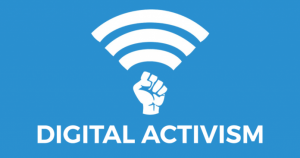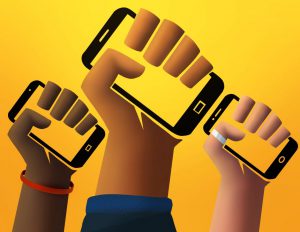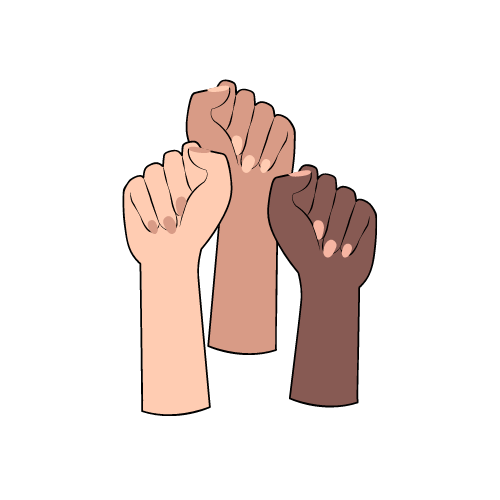
In my first blog post, I will dig deeper into the fact that digital activism and online protests have replaced many of the “street protests”. I will also discuss how people have found various ways to spread messages and important information. I will draw on an academic article and apply theories on contemporary events and movements.
Black Lives Matter (BLM) is a movement that has been in the light for many years but mainly from 2013 when the BLM-project was created in the US as a response to the acquittal of Trayvon Martin´s murderer, George Zimmerman[1]. Today, BLM is more relevant than ever as the oppression against black people is more observed than ever.
[1] https://blacklivesmatter.com/herstory/
Theories
Thomas Poell and José Van Dijck (2018) discuss potentials and issues with digital activism and online protesting. By applying their theories on current digital activism and movements, we can create a larger understanding for how digital activism can affect the organization and communication of contemporary protests and movements (Poell & Van Dijck, 2018: 2). The BLM-movement and its protests are more or less only communicated, presented and discussed in media today. In some places of the world, classic “street protests” has taken place but due to the Covid-19 outbreak, the majority part of the movement has been moved online. However, Poell and Van Dijck (2018) argues that the question is not whether the activity on social media is more important than the street protests, or whether the rise of the media-movement is the “cause” of popular uprisings. The question is how digital activism and online movements and protests affects the actual protests- the desired goal. The online and offline protests and activism have to be unfolded because almost every activist carries a smartphone and have continuous access to online platforms to share their content. Protests, therefore, unfolds on the streets and online (Poell & Van Dijck, 2018: 2-3).
People tend to construct networks and movements that take shape locally on the streets and globally on social media platforms. Also, the development of New ICTs (NICTs) is relevant to connect to these discussions as the social interaction between activists is increasing. Groups of people communicate online about how to organize protests, as well as spreading messages and news about the movement. Therefore, NICTs are not just innovative means of communication, it also works as effective organization tools (Heeks, 2017: 30-31).
"A "we" can emerge but just as quickly disappear"
One of the many pros about the development of NICTs and digital activism is that it transforms the initial dynamic of activism as they create “togetherness”. This allows people to look past fear and develop hope. This can be a good outcome of digital activism as participation can be deeper than on the streets. Poell and Van Dijck (2018) shows that the motivation and the emotional connection to a certain movement can be increased by online protesting and activism, as it encourages and almost demands self-organization (Poell & Van Dijck, 2018: 7).
Regarding the BLM-movement, we can for sure see that the movement creates collectivity, togetherness and a “we can change the world”-feeling. Names, pictures, videos and signature-lists are spread online across the globe, which today is the most effective way to reach people and to get their attention. However, Poell and Van Dijck (2018) want to mention “the logic of aggregation” when talking about such instances of collectivity as these relations are by no means stable. “A “we” can emerge but just as quickly disappear.”- (Poell & Van Dijck, 2018: 7). When activists and individuals all over the globe come together, they forge a collective subjectivity that is under the constant pressure of disaggregation into its components (Poell & Van Dijck, 2018: 7-8, 10). Therefore, the current BLM-movement could expect some disaggregation, but the movement as a whole has been going on for too long and it is too relevant for too many people that it will not be erased. However, it should be kept in mind that for the long-term change, development and result of the BLM-movement, offline-interaction is also important to create a long term-collectivity. Social justice requires collective and offline action to be realised, according to Linnet Taylor (2017) (Taylor, 2017: 8).

Discussion
To take the discussion one step further, these theories should be applied to the contemporary society we all are living in. We have learned that people adapt in difficult times, as a surviving strategy. People all over the globe are trying to find a “new normal” in the middle of a global pandemic. Thus, the chances that most of the anti-digital activism theories can be proved wrong are big, as the conditions are very particular and the mindsets have been affected, as we do not have many other choices than conducting activism online. Also, Poell and Van Dijck (2018) mention that communication- and mobilization strategies, and digital activism have developed and changed over the years, and even more in times of uncertainty and crisis (Poell & Van Dijck, 2018: 13).
Regarding social justice behind the screens, I would like to say that I believe more people will feel involved and as they can make a difference when you can participate in protests and movements online. Almost everyone has access to social media and various platforms, and it is the most effective way to reach out to a large number of people in a short time. Therefore, social justice amongst people and especially black people is in my opinion more likely to be achieved in a “datayfing” world and in times when it is possible to personally connect to the problem and to come as close as possible to the actual issues, as you do when you are being fed with visual images and videos of people being oppressed. On the other hand, it is also a pretty easy way out as you could just shut off your phone or computer and in a second you could “escape” the news, messages and movements.
Are the development of New ICTs and the increased digital activism and online protesting a step in the right direction for a global movement such as the BLM-movement? Please discuss in the comments!
References
Heeks, Richard. 2017. Information and Communication Technology for Development (ICT4D). First Ed. Taylor and Francis Group.
Poell, Thomas & José van Dijck (2018). Social Media and new protest movements. In The SAGE Handbook of Social Media, 546-561, edited by Jean Burgess, Alice Marwick & Thomas Poell. London: Sage.
Taylor, Linnet. (2017). What is data justice? The case for connecting digital rights and freedoms globally. London: Sage. Doi: 10.1177/2053951717736335.
Websites
https://blacklivesmatter.com/
Photos
Digital activism, real-life slackening or is this the death of Maslow’s theorem?

